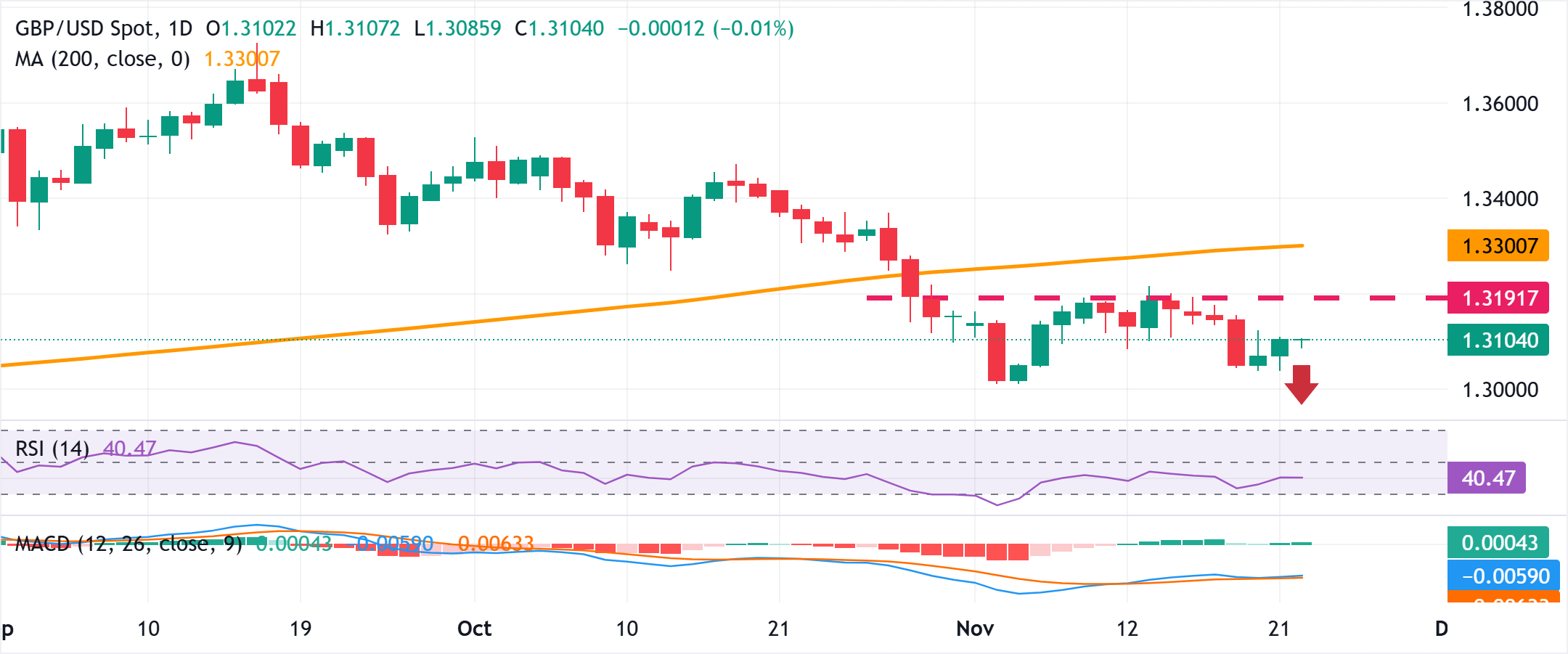GBP/USD Price Forecast: Looks to build on move beyond 1.3100; not out of the woods yet
- GBP/USD attracts some dip-buyers during the Asian session, though it lacks bullish conviction.
- The UK budget uncertainty and BoE rate cut bets act as a headwind for the GBP and the pair.
- The bearish technical setup backs the case for the emergence of fresh sellers at higher levels.
The GBP/USD pair reverses a modest Asian session dip and climbs back above the 1.3100 mark in the last hour amid a modest US Dollar (USD) downtick on Monday. However, the uncertainty surrounding the upcoming UK budget and rising bets for an interest rate cut by the Bank of England (BoE) next month should act as a headwind for spot prices.
From a technical perspective, the recent breakdown below the very important 200-day Simple Moving Average (SMA) was seen as a key trigger for the GBP/USD bears. Moreover, oscillators on the daily chart are holding deep in negative territory and back the case for the emergence of some sellers near the 1.3120-1.3125 region. This is followed by resistance near the 1.3155-1.3160 region, or last week's swing high, which, if cleared, might trigger a fresh bout of a short-covering move.
The subsequent move up could assist the GBP/USD pair to reclaim the 1.3200 round figure and climb further beyond the 1.3250 intermediate hurdle, towards testing a technically significant 200-day SMA, currently around the 1.3300 mark. A sustained move beyond the latter might shift the near-term bias in favor of bullish traders and pave the way for some meaningful appreciating move in the near term.
On the flip side, the 1.3040-1.3035 region, or an over two-week low touched last Thursday, might continue to offer immediate support ahead of the 1.3000 psychological mark. A convincing break below the latter would expose the next relevant support near the 1.2950 zone before the GBP/USD pair extends the downward trajectory further and eventually drops to test sub-1.2900 levels.
GBP/USD daily chart

Pound Sterling FAQs
The Pound Sterling (GBP) is the oldest currency in the world (886 AD) and the official currency of the United Kingdom. It is the fourth most traded unit for foreign exchange (FX) in the world, accounting for 12% of all transactions, averaging $630 billion a day, according to 2022 data. Its key trading pairs are GBP/USD, also known as ‘Cable’, which accounts for 11% of FX, GBP/JPY, or the ‘Dragon’ as it is known by traders (3%), and EUR/GBP (2%). The Pound Sterling is issued by the Bank of England (BoE).
The single most important factor influencing the value of the Pound Sterling is monetary policy decided by the Bank of England. The BoE bases its decisions on whether it has achieved its primary goal of “price stability” – a steady inflation rate of around 2%. Its primary tool for achieving this is the adjustment of interest rates. When inflation is too high, the BoE will try to rein it in by raising interest rates, making it more expensive for people and businesses to access credit. This is generally positive for GBP, as higher interest rates make the UK a more attractive place for global investors to park their money. When inflation falls too low it is a sign economic growth is slowing. In this scenario, the BoE will consider lowering interest rates to cheapen credit so businesses will borrow more to invest in growth-generating projects.
Data releases gauge the health of the economy and can impact the value of the Pound Sterling. Indicators such as GDP, Manufacturing and Services PMIs, and employment can all influence the direction of the GBP. A strong economy is good for Sterling. Not only does it attract more foreign investment but it may encourage the BoE to put up interest rates, which will directly strengthen GBP. Otherwise, if economic data is weak, the Pound Sterling is likely to fall.
Another significant data release for the Pound Sterling is the Trade Balance. This indicator measures the difference between what a country earns from its exports and what it spends on imports over a given period. If a country produces highly sought-after exports, its currency will benefit purely from the extra demand created from foreign buyers seeking to purchase these goods. Therefore, a positive net Trade Balance strengthens a currency and vice versa for a negative balance.
